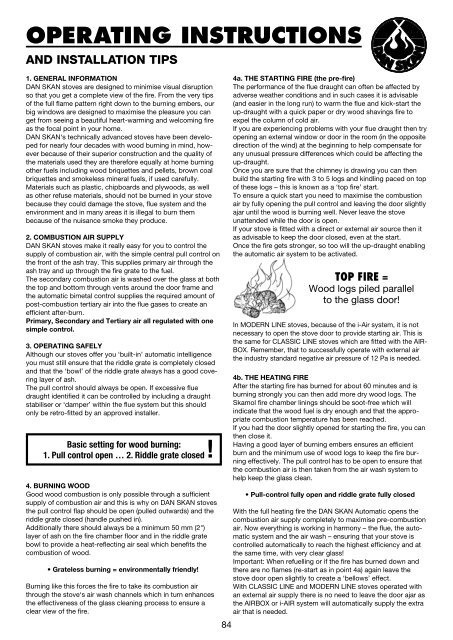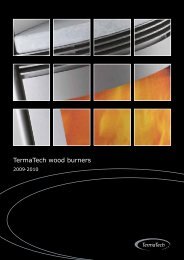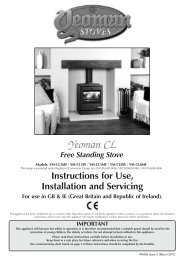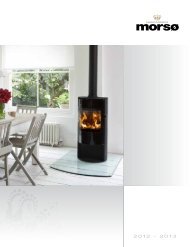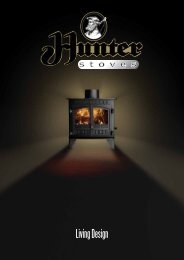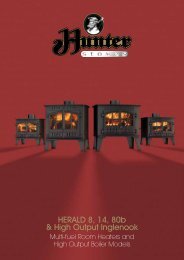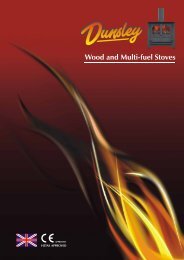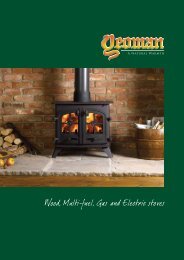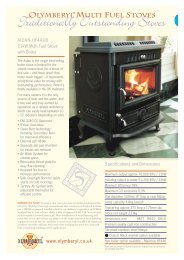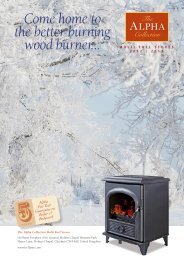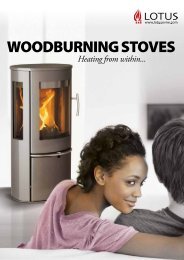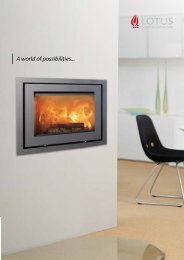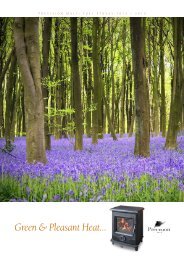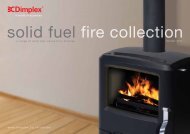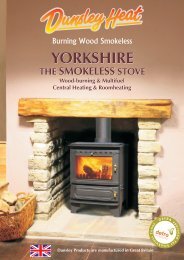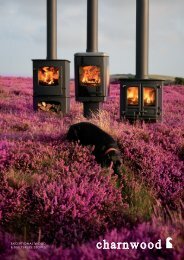You also want an ePaper? Increase the reach of your titles
YUMPU automatically turns print PDFs into web optimized ePapers that Google loves.
OPERATING INSTRUCTIONS<br />
AND INSTALLATION TIPS<br />
1. GENERAL INFORMATION<br />
Dan SKan stoves are designed to minimise visual disruption<br />
so that you get a complete view of the fire. From the very tips<br />
of the full flame pattern right down to the burning embers, our<br />
big windows are designed to maximise the pleasure you can<br />
get from seeing a beautiful heart-warming and welcoming fire<br />
as the focal point in your home.<br />
Dan SKan‘s technically advanced stoves have been developed<br />
for nearly four decades with wood burning in mind, however<br />
because of their superior construction and the quality of<br />
the materials used they are therefore equally at home burning<br />
other fuels including wood briquettes and pellets, brown coal<br />
briquettes and smokeless mineral fuels, if used carefully.<br />
Materials such as plastic, chipboards and plywoods, as well<br />
as other refuse materials, should not be burned in your stove<br />
because they could damage the stove, flue system and the<br />
environment and in many areas it is illegal to burn them<br />
because of the nuisance smoke they produce.<br />
2. COMBUSTION AIR SUPPLY<br />
Dan SKan stoves make it really easy for you to control the<br />
supply of combustion air, with the simple central pull control on<br />
the front of the ash tray. This supplies primary air through the<br />
ash tray and up through the fire grate to the fuel.<br />
<strong>The</strong> secondary combustion air is washed over the glass at both<br />
the top and bottom through vents around the door frame and<br />
the automatic bimetal control supplies the required amount of<br />
post-combustion tertiary air into the flue gases to create an<br />
efficient after-burn.<br />
Primary, Secondary and Tertiary air all regulated with one<br />
simple control.<br />
3. OPERATING SAFELY<br />
although our stoves offer you ‘built-in’ automatic intelligence<br />
you must still ensure that the riddle grate is completely closed<br />
and that the ‘bowl’ of the riddle grate always has a good covering<br />
layer of ash.<br />
<strong>The</strong> pull control should always be open. if excessive flue<br />
draught identified it can be controlled by including a draught<br />
stabiliser or ‘damper’ within the flue system but this should<br />
only be retro-fitted by an approved installer.<br />
Basic setting for wood burning:<br />
1. Pull control open … 2. Riddle grate closed!<br />
4. BURNING WOOD<br />
good wood combustion is only possible through a sufficient<br />
supply of combustion air and this is why on Dan SKan stoves<br />
the pull control flap should be open (pulled outwards) and the<br />
riddle grate closed (handle pushed in).<br />
additionally there should always be a minimum 50 mm (2")<br />
layer of ash on the fire chamber floor and in the riddle grate<br />
bowl to provide a heat-reflecting air seal which benefits the<br />
combustion of wood.<br />
• Grateless burning = environmentally friendly!<br />
Burning like this forces the fire to take its combustion air<br />
through the stove‘s air wash channels which in turn enhances<br />
the effectiveness of the glass cleaning process to ensure a<br />
clear view of the fire.<br />
84<br />
4a. THE STARTING FIRE (the pre-fire)<br />
<strong>The</strong> performance of the flue draught can often be affected by<br />
adverse weather conditions and in such cases it is advisable<br />
(and easier in the long run) to warm the flue and kick-start the<br />
up-draught with a quick paper or dry wood shavings fire to<br />
expel the column of cold air.<br />
if you are experiencing problems with your flue draught then try<br />
opening an external window or door in the room (in the opposite<br />
direction of the wind) at the beginning to help compensate for<br />
any unusual pressure differences which could be affecting the<br />
up-draught.<br />
Once you are sure that the chimney is drawing you can then<br />
build the starting fire with 3 to 5 logs and kindling paced on top<br />
of these logs – this is known as a ‘top fire’ start.<br />
To ensure a quick start you need to maximise the combustion<br />
air by fully opening the pull control and leaving the door slightly<br />
ajar until the wood is burning well. never leave the stove<br />
unattended while the door is open.<br />
if your stove is fitted with a direct or external air source then it<br />
as advisable to keep the door closed, even at the start.<br />
Once the fire gets stronger, so too will the up-draught enabling<br />
the automatic air system to be activated.<br />
TOP firE =<br />
Wood logs piled parallel<br />
to the glass door!<br />
in MODErn linE stoves, because of the i-air system, it is not<br />
necessary to open the stove door to provide starting air. This is<br />
the same for ClaSSiC linE stoves which are fitted with the air-<br />
BOX. remember, that to successfully operate with external air<br />
the industry standard negative air pressure of 12 Pa is needed.<br />
4b. THE HEATING FIRE<br />
after the starting fire has burned for about 60 minutes and is<br />
burning strongly you can then add more dry wood logs. <strong>The</strong><br />
Skamol fire chamber linings should be soot-free which will<br />
indicate that the wood fuel is dry enough and that the appropriate<br />
combustion temperature has been reached.<br />
if you had the door slightly opened for starting the fire, you can<br />
then close it.<br />
Having a good layer of burning embers ensures an efficient<br />
burn and the minimum use of wood logs to keep the fire burning<br />
effectively. <strong>The</strong> pull control has to be open to ensure that<br />
the combustion air is then taken from the air wash system to<br />
help keep the glass clean.<br />
• Pull-control fully open and riddle grate fully closed<br />
With the full heating fire the Dan SKan automatic opens the<br />
combustion air supply completely to maximise pre-combustion<br />
air. now everything is working in harmony – the flue, the automatic<br />
system and the air wash – ensuring that your stove is<br />
controlled automatically to reach the highest efficiency and at<br />
the same time, with very clear glass!<br />
important: When refuelling or if the fire has burned down and<br />
there are no flames (re-start as in point 4a) again leave the<br />
stove door open slightly to create a ‘bellows’ effect.<br />
With ClaSSiC linE and MODErn linE stoves operated with<br />
an external air supply there is no need to leave the door ajar as<br />
the airBOX or i-air system will automatically supply the extra<br />
air that is needed.


